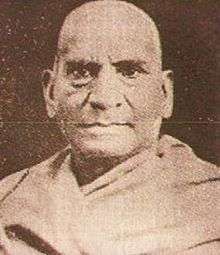Shuddhi
Shuddhi is Sanskrit for purification. In Hinduism it is a part of worship. It also refers to converting to Hinduism.
Shuddhi movement
The socio-political movement, derived from ancient rite of shuddhikaran,[1] or purification was started by the Arya Samaj, and its founder Swami Dayanand Saraswati [2] and his followers like Swami Shraddhanand, who also worked on the Sangathan consolidation aspect of Hinduism, in North India, especially Punjab in early 1900s, though it gradually spread across India.[2] Shuddhi had a social reform agenda behind its belligerent rationale and was aimed at abolishing the practise of untouchability by converting outcasts from other religions to Hinduism and integrating them into the mainstream community by elevating their position, and instilling self-confidence and self-determination in them.[2][3][4] The movement strove to reduce the conversions of Hindus to Islam and Christianity, which were underway at the time.[2]

In 1923, Swami Shraddhanand founded the 'Bhartiya Hindu Shuddhi Mahasabha' (Indian Hindu Purification Council) and pushed the agenda of reconversion peacefully, but ultimately created a flashpoint between Hindus and Muslims as it offended Muslim exceptionalists, who argued that Hindus, being dhimmis, do not have any rights to convert others to their faith unlike the Muslims, who are mumins. The main point of contention was the reconversion Malkana Rajputs in western United Province [5] Subsequently the movement became controversial and antagonized the Muslims populace to no end [3] and also led to the death of the leader of the movement, Swami Shraddhanand in 1926. Post Swami Shraddhanand death this movement continued with similar missionary zeal.[6]
On 23 February 1928, many Catholic Gaudes in Goa were re-converted to Hinduism notwithstanding the opposition of the Church and the Portuguese government.[7] This was carried out by a Hindu religious institution from Mumbai known as Masurashram, the converts were given Hindu names, but the Portuguese government put impediments in their way to get legal sanction for their new Hindu names.[8] 4851 Catholic Gaudes from Tiswadi, 2174 from Ponda, 250 from Bicholim and 329 from Sattari were re-converted to Hinduism after nearly 400 years. The total number of the converts to Hinduism was 7815.[9] However, in Northern India this movement faced stiff opposition from Sunni Barelvi organisation All India Jamaat Raza-e-Mustafa[10] in Bareilly city which initiated counter to Shuddhi Movement to save Muslims from being converted into Hinduism in undivided India.[11]
See also
References
- ↑ Hindu-Muslim Relations in British India: A Study of Controversy, Conflict, and Communal Movements in Northern India 1923-1928, by G. R. Thursby. Published by BRILL, 1975. ISBN 90-04-04380-2. Page 136.
- 1 2 3 4 Dayanand and the Shuddhi Movement Indian Political Tradition, by D.K Mohanty. Published by Anmol Publications PVT. LTD. ISBN 81-261-2033-9. Page 116.
- 1 2 untouchable assertion The Politics of the Urban Poor in Early Twentieth-century India, by Nandini Gooptu. Published by Cambridge University Press, 2001. ISBN 0-521-44366-0. Page 157.
- ↑ The Khilafat Movement: Religious Symbolism and Political Mobilization in India, by Gail Minault. Published by Columbia University Press, 1982. ISBN 0-231-05072-0. Page 193.
- ↑ The Fundamentalism Project, by Martin E. Marty, R. Scott Appleby, American Academy of Arts and Sciences. Published by University of Chicago Press, 1991.ISBN 0226508781. Page 564.
- ↑ Hindu Nationalism and the Language of Politics in Late Colonial India, by William Gould. Published by Cambridge University Press, 2004. ISBN 0-521-83061-3. Page 133.
- ↑ Ghai, R. K. (1990). Shuddhi movement in India: a study of its socio-political dimensions. Commonwealth Publishers,. pp. 208 pages (see page 103). ISBN 9788171690428.
- ↑ Ralhan, Om Prakash (1998). Post-independence India: Indian National Congress, Volumes 33-50. Anmol Publications PVT. LTD.,. pp. 6330 pages (see pages 304–305). ISBN 9788174888655.
- ↑ Godbole, Shriranga (December 2010). Sanskrutik Vartapatra. Pune: Sanskrutik Vartapatra. pp. 61–66 & 112.
- ↑ "JRM". jamatrazaemustafa.org. Retrieved 2015-07-28.
- ↑ Hasan, M.; Jamia Millia Islamia (India). Dept. of History (1985). Communal and pan-Islamic trends in colonial India. Manohar. Retrieved 2015-07-28.
Further reading
- Socio-Religious Reform Movements in British India: Socio-Religious Reform Movements in British India, Volume III-I, by Kenneth W. Jones. Published by Cambridge University Press, 1987. ISBN 0-521-24986-4.
- Shuddhi Movement in India: A Study of Its Socio-political Dimensions, by R. K. Ghai. Published by Commonwealth Publishers, 1990.
- Hindu Nationalism: Origins, Ideologies and Modern Myths, by Chetan Bhatt. Published by Berg Publishers, 2001. ISBN 1-85973-348-4.
- Religion in South Asia: Religious Conversion and Revival Movements in South Asia in Medieval and Modern Times, by Geoffrey A. Oddie. Published by Manohar, 1991. Chapter 10: Reconversion to Hinduism: The Shuddhi of the Arya Samaj. Page 215.